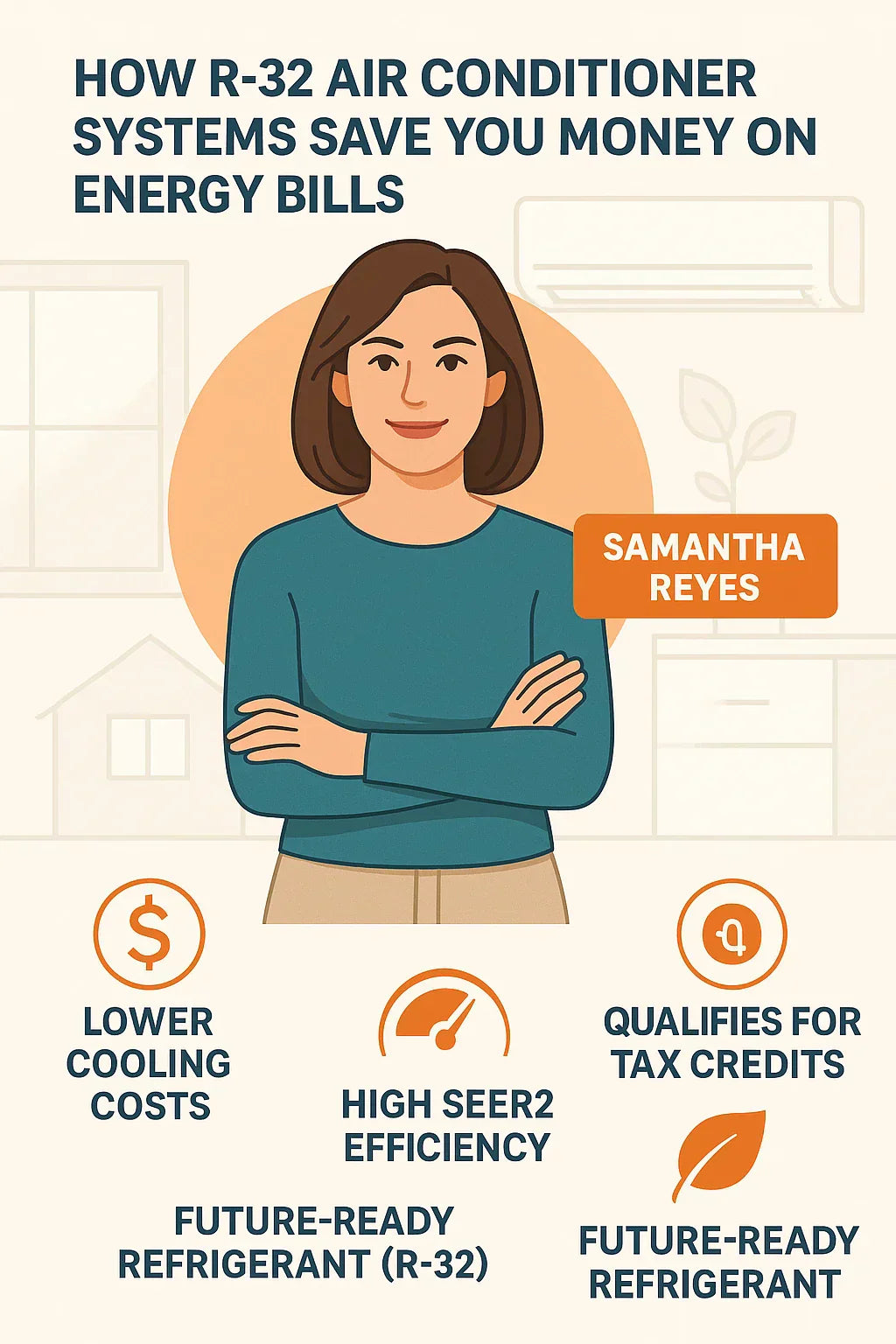Smart cooling for smarter homes—discover how R-32 systems deliver year-round savings without compromising performance.
💸 Introduction: Why Energy Efficiency Starts with the Right Refrigerant
If you're like Samantha Reyes, you want to keep your home cool without seeing your energy bills spike every summer. In 2025, HVAC efficiency is about more than SEER ratings and programmable thermostats—it's about what's inside your system.
That’s where R-32 refrigerant comes in. Already popular across Europe and Asia, R-32 is now becoming the go-to choice in U.S. households for one reason: it helps you save money. Here’s how.
🧊 What Makes R-32 More Efficient Than R-410A?
🔍 R-32 vs. R-410A: Cooling Power Comparison
| Property | R-410A | R-32 |
|---|---|---|
| Global Warming Potential (GWP) | 2,088 | 675 |
| Cooling Efficiency | Moderate | High |
| Refrigerant Charge Volume | Higher | 20–30% Less |
| Heat Transfer Ability | Lower | Better |
| SEER2 Impact | Meets minimum | Exceeds minimum |
R-32’s thermal conductivity is 1.5 times higher than R-410A, meaning your AC cools faster using less electricity.
📖 Daikin’s R-32 Efficiency Report shows how systems using R-32 consume up to 10% less power than traditional R-410A units.
📈 SEER2 Ratings and Real-World Impact
💡 What Is SEER2?
SEER2 (Seasonal Energy Efficiency Ratio 2) is the updated measurement of AC efficiency under real-world, field conditions.
-
Higher SEER2 = lower energy use
-
New U.S. minimums for 2023+:
-
Northern states: ≥13.4 SEER2
-
Southern states: ≥14.3 SEER2
-
Most R-32 systems exceed these values, often ranging from 15.2 to 20 SEER2.
🔗 Verify ratings at Energy Star Certified Room AC Database
🧮 Estimating Your Annual Savings with R-32
Let’s look at a real-world example Samantha Reyes might face:
🏠 Home Profile
-
1,700 sq. ft. home in Raleigh, NC
-
Summer temps reach 95°F+
-
Previously using a 12-year-old 3-ton R-410A unit at 13 SEER
💰 Cost Comparison
| Factor | Old Unit (13 SEER) | R-32 System (16.5 SEER2) |
|---|---|---|
| Yearly kWh usage | ~3,600 kWh | ~2,830 kWh |
| Average cost/kWh | $0.14 | $0.14 |
| Annual Cooling Cost | $504 | $396 |
| Annual Savings | — | $108/year |
Over 10 years, that’s $1,080 in energy savings—not including maintenance and rebates.
📎 Use the AC Savings Calculator to run your own numbers.
🌡️ More Precise Cooling = More Money Saved
🌀 Variable-Speed Air Handlers
Most modern R-32 systems pair with inverter or variable-speed air handlers, meaning:
-
The system runs continuously at lower speeds
-
Less energy is wasted turning on/off
-
More consistent indoor temperatures
This lowers energy use and also improves humidity control, meaning Samantha can set her thermostat a few degrees higher without sacrificing comfort.
🛠️ Reduced Maintenance = Fewer Service Calls
R-32 systems are:
-
Less prone to overheating
-
Use smaller refrigerant volumes (easier to detect and correct leaks)
-
Compatible with more compact coils (easier to maintain and clean)
A well-maintained R-32 system requires fewer service calls, cutting down your long-term HVAC expenses.
💵 Do R-32 Systems Qualify for Rebates?
Absolutely. In fact, many utility providers are prioritizing low-GWP refrigerant systems in 2025 rebate programs.
🧾 Available Incentives
-
Federal tax credit (IRA 25C):
Up to $2,000 for high-efficiency ACs -
ENERGY STAR® Rebates:
$300–$1,000 depending on region -
State/local utility incentives:
Use DSIRE USA to find local programs
💡 Tip: To qualify, your R-32 system must meet minimum SEER2 standards and often be AHRI certified.
🔧 Installation Cost vs. Long-Term Return
Upfront Costs (2025 Averages):
| System | Price (Unit Only) | Price (Installed) |
|---|---|---|
| R-410A 3-ton | $2,800 | $6,000–$8,000 |
| R-32 3-ton | $3,000–$3,500 | $6,500–$8,500 |
The $200–$500 difference is often offset within 2–3 years through:
-
Lower power bills
-
Tax credits
-
Less frequent servicing
📊 On average, R-32 owners break even in Year 3–4 and continue saving for a decade or more.
🧯 Is R-32 Safe and Reliable Long-Term?
Yes—R-32 is classified as A2L (mild flammability) but is extremely safe in properly installed systems.
-
Used in millions of homes globally for over 10 years
-
Most systems include built-in leak detection or safety sensors
Installers working with R-32 must follow updated safety and ventilation guidelines, reducing homeowner risk.
🛒 Where to Buy and How to Compare R-32 Systems
You’ll find R-32 packaged systems from top brands like:
Always verify:
SEER2 rating
Refrigerant type
ENERGY STAR certification
AHRI certificate number
📋 Samantha’s Checklist for R-32 Energy Savings
✅ My home is 1,500–2,000 sq. ft.
✅ I want lower energy bills
✅ I’m replacing a system from 2010 or earlier
✅ I qualify for federal or local rebates
✅ I want a system that’s ready for the next 10+ years
If you checked 3+ of these, you’re a great candidate for an R-32 upgrade.
In the next topic we will kow more about: Air Handler Basics — What They Do and How They Pair with R-32 AC Systems







